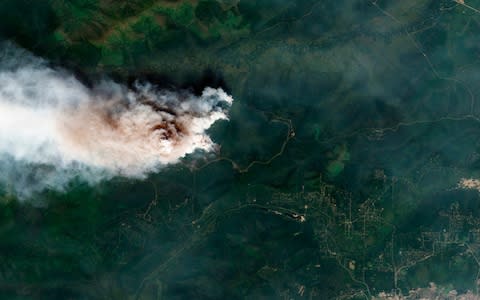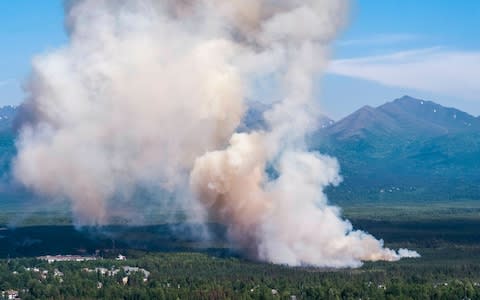Climate change warning as Arctic Circle burning at record rate

An unprecedented outbreak of wildfires in the Arctic has sent smoke across Eurasia and released more carbon dioxide in two months than the Czech Republic or Belgium does in a year.
As 44C heatwaves struck Europe, scientists observed more than 100 long-lasting, intense fires in the Arctic in June, the hottest month on record, and are seeing even more in July, according to Mark Parrington of the European Centre for Medium-Range Weather Forecasts.
Mostly in Alaska and Russia, the infernos have collectively released more than 120 million tonnes of CO2, more than the annual output of most countries. It is the most carbon emitted since satellite monitoring began in the early 2000s.
This will further exacerbate climate change and has sent smoke pouring toward more populated parts of the world. Pollutants can persist more than a month in the atmosphere and spread thousands of kilometres.
“You ask people about the Arctic, they think ice, polar bears, a clean environment, but clearly that's changing and that's no longer the case,” Mr Parrington said.
“It should be an alarm bell that something isn't right, but the way it could directly affect them is the long-range transfer of smoke pollution. I don't think it's getting as far as western Europe just yet but that could happen.”

While some have estimated that up to half a million kilometres have burned worldwide this year, Russia has been especially hard hit. Already, dangerous levels of smoke pollution have been reported this week in the cities of Chelyabinsk, Tomsk and Novosibirsk, where a curtain of smog turned the daytime sun a deep red. The number of patients in some cardiac wards have reportedly doubled.
Fires first erupted in the peatlands of northern Siberia in June and have been joined by blazes in the massive boreal forests south of the Arctic circle.
More than 30,000 square kilometres of Russian territory are currently burning, already about as much as in 2018 and twice as much as in 2017.
This has created a 4.5 million square kilometre “smoke lid” that reaches as far east as the Pacific Ocean and as far south as Kazakhstan.
To the west, thick smoke haze has drifted into more populated parts of the country, obscuring the streets of cities like Yekaterinburg and Perm and being detected all the way in Kazan on the Volga River.
“This morning I thought a rubbish bin was burning outside the window, but it hasn't passed, the smoke is staying there,” Yekaterinburg resident Yevgenia Panasyuk told local television.
Impressive extent of heavy smoke across much of central Russia/Siberia, Alaska & Canada from numerous intense boreal & #Arctic#wildfires shows up in latest #Copernicus Atmosphere Monitoring Service aerosol optical depth forecast https://t.co/N5E33mccshpic.twitter.com/br0kkT02HY
— Mark Parrington (@m_parrington) July 24, 2019
Once rare in the cold, wet tundra and forests, fires in the Arctic, which is warming at twice the world average, have been flaring up with increasing frequency.
The Copernicus satellite system has observed an average of 50 to 60 Arctic hotspots on summer days since it began monitoring in 2003. This summer it has been seeing about 250 per day.
And while in the past Arctic blazes would typically go out in a few days, the duration of this year's fires, many of which of have been burning for nearly two months, is shocking, Mr Parrington said.
The long-term effects could be dire. Already in June, fires began to deposit soot known as “black carbon” on Arctic sea ice, accelerating its melt.
Russia has mobilised 2,715 personnel and 28 aircraft but they are only fighting fires in about 1,500 square kilometres of territory.

Like in Alaska and Canada, not all fires here receive a response. Since 2015, Russia has declined to combat blazes in vast, remote “control zones” unless they threaten towns. “The logic is clear, we need to save money,” the head of the Krasnoyarsk region said this month.
But the policy of leaving fires alone until they spread to populated areas has resulted in an “environmental disaster at a national level,” Greenpeace Russia said on Friday.
It claimed that hundreds of villages were within the control zones, calling on these boundaries to be redrawn and for the government to send additional firefighting forces to defend villages.
Also on Friday, a study published in Science found that some Alaskan glaciers were melting 100 times faster than previously thought. Drawing on data about the terminus of a glacier in LeConte Bay collected by local high students since 1983, scientists scanned the glacier with sonar, radar and time-lapse cameras for two summers to discover that the underwater part of it was melting up to 16 feet per day in August.
Their results have demonstrated that glaciers are more sensitive to warming ocean temperatures than researchers had known.

